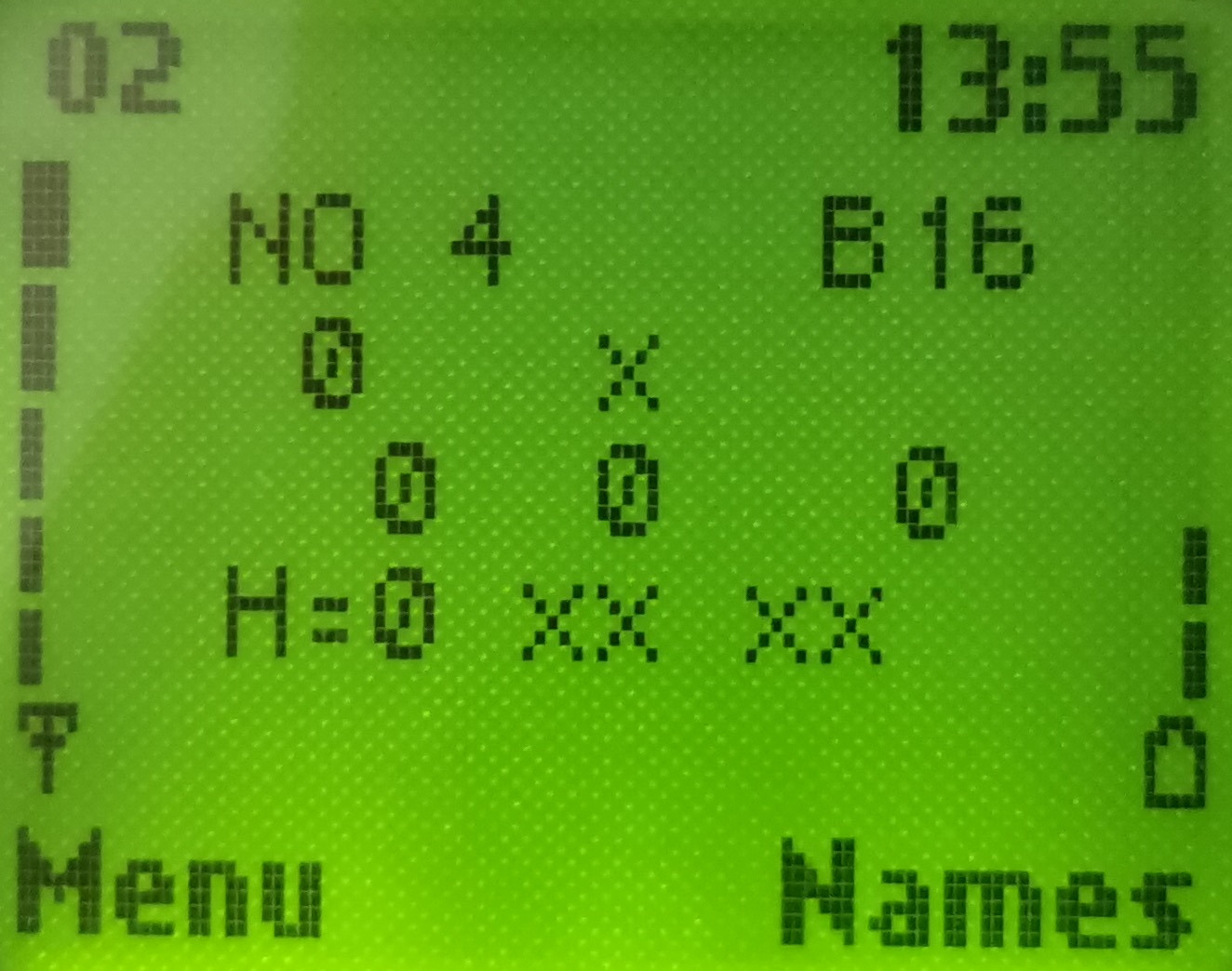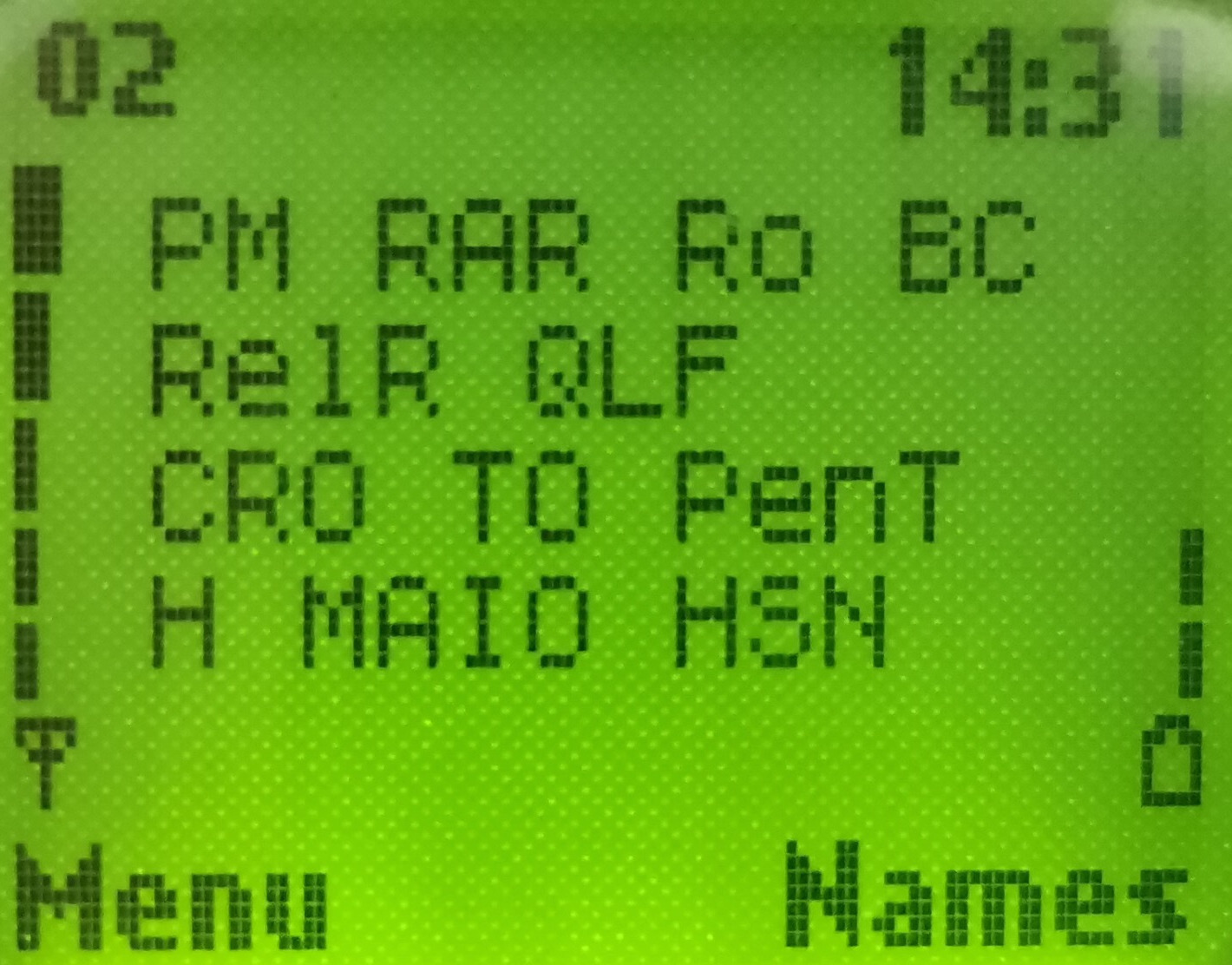Main page
News
Guest book
Home bs0dd.net
Phones
List of modelsFirmware
Net Monitor
FT/NM activationNet Monitor (DCT3)
Net Monitor (DCT4)
Soft and games
Java MIDletsOfficial soft
Soft for 5510
PC software
Connectivity
Data-CablesFLOSYS FBUS/MBUS docs
DLR-3 MBUS (atrox)
Modding
Color display (6310)Soft for DCT3 modding
WAP
WAP-gatewayWAP-page
Other
Nokia 9210 archiveElektronika MK
Kannel for Windows
Nokia Net Monitor description (DCT3)
MAIN PAGE
< PREVIOUS PAGE
NEXT PAGE >
Test 02 – Serving Cell Information (2)
Available in: 2100, 3330, 5110, 6150, 6210, 7110, 8210, 8250
This test displays information about signal, selection characteristics and communication with the serving BTS.
| Test screen | Help screen |
 |
 |
PM: Paging mode. This indicates the manner in which the phone shall monitor paging and immediate assignment messages on the PCH (Paging sub-CHannel of the CCCH). Values are:
| Page Mode | Meaning |
| NO – Normal Paging | MS decodes only messages in its PCH. |
| EX – Extended Paging | The MS is required to decode the 2nd PCH message from the last one. |
| RO – Paging Reorganisation | The MS is required to decode all messages on the CCCH and BCCH. |
| SB – Same as Before | The MS does not change its paging mode. |
Note the MS changes its paging mode to whatever the last paging message commanded. This is why there is the SB mode, which instructs the MS to leave its paging mode as it is. [GSM 04.08:3.3.2.1.1]
RAR: Maximum number of retransmissions allowed on the RACH when requesting a channel. RACH (Random Access CHannel) is used for requesting dedicated channels. Can be 1, 2, 4, or 7. [GSM 04.08:3.3.1.1.2]
Ro: Roaming Indicator. When the phone is roaming a foreign GSM network, it displays ‘R’. Otherwise, it is not displayed.
BC: BSIC value of current cell. This value is broadcast on the SCH (in a synchronization burst) in order to help the MS distinguish BTSs that may share the same radio channel. It is a 6-bit value, the first 3-bits are used to distinguish between carriers using the same BCCH radio channels, and the last 3-bits to distinguish between different BTSs using same BCCH radio channels. [GSM 03.03:A.1, 05.08:7.2]
RelR: This displays the reason the last call was terminated (released). See “Test 39 – Reason for Last Call Release” for more information. [GSM 04.08:F,G,H]
QLF: The RXQUAL value. This value, when the phone is communicating with the BTS, shows the received signal quality, calculated from the Bit Error Rate (BER). It displays ‘x’ when in idle mode. The RXQUAL value ranges from 0 to 7, where 0 shows the least errors (BER < 0.2%) and 7 shows the most errors (BER > 12.8%). The higher the value, the poorer quality signal and the more likely communication will fail. This value is only displayed in dedicated mode (since it only applies there). The meaning of the values are detailed in “Test 01 – Serving Cell Information (1)”. [GSM 05.08:8.2.4]
CRO: This displays the cell reselect offset (CRO), used to calculate the C2 value. It is the value added or subtracted to the C1 value. It is used to give a “weighting” to certain cells for camping. Ranges from 0 – 126 in steps of 2dBm. Normally this value is added to the C1 value, however, by setting the penalty time to a reserved value (31), this value is subtracted from the C1 value. Obviously, this means the temporary offset cannot be used in conjunction with a subtracted CRO. To determine if the CRO is being subtracted, normally this involves calculating the difference between C1 and C2. Additionally, if the value is being subtracted, Penalty Time will always appear as 620 seconds. This value is only displayed in idle mode, otherwise it is displayed as ‘x’s. [GSM 05.08:6.4]
TO: This displays the temporary offset, used to calculate the C2 value. It is a value subtracted from the C1 value, like the cell reselect offset. However, it is only applied temporarily, i.e. for a certain period of time after the phone finds this cell. Then, it is removed. This is useful for cells where the MS is likely to be moving at a high enough speed such as that it will move out of range of the BTS too quickly. If the MS however is within range long enough to exceed the time period (see next section), then it can camp on the cell. Temporary offset is in steps of 10dB from 0 to 70. A value of 70dB means ‘infinite’, i.e. the cell cannot be used during the time period. This value is only displayed in idle mode, otherwise ‘x’s are shown. [GSM 05.08:6.4]
PenT: This displays the penalty time, which is how long the temporary offset is applied after the cell is placed on the monitoring list. After this time the temporary offset is removed when calculating the C2 value. Penalty time is in steps of 20 seconds, ranging from 0 to 620. This value is only displayed in idle mode, otherwise ‘x’s are shown. [GSM 05.08:6.4]
H: Indicates whether frequency hopping is used. Displays 1 for yes, or 0 for no. This value can only be 1 in dedicated mode. [GSM 05.02:6.2.3]
MAIO: Mobile Allocation Index Offset. A value ranging from 0 to 63, this ‘seeds’ the phone into the hopping sequence. This allows phones to be sharing the same timeslot and radio channels by hopping to different frequencies at different times. This value is displayed as ‘x’s when hopping is off. [GSM 05.02:6.2.2]
HSN: Hopping Sequence Number, a 6-bit value ranging from 0 to 63, this also is used in the calculation of the hopping sequence. If the value is 0, cyclic hopping is used (where the mobile steps through the assigned channels in sequence from the first to the last and back to the first). This value is displayed as ‘x’s when hopping is off. [GSM 05.02:6.2.2]
In some phones (for example, Nokia 8810 or Nokia 5110 with older firmware) you will see parameters in two first lines only...
Port: 9201
Переключиться на Русский
Powered by COMPPAG 0.56
2022-2025 © Compys S&N Systems